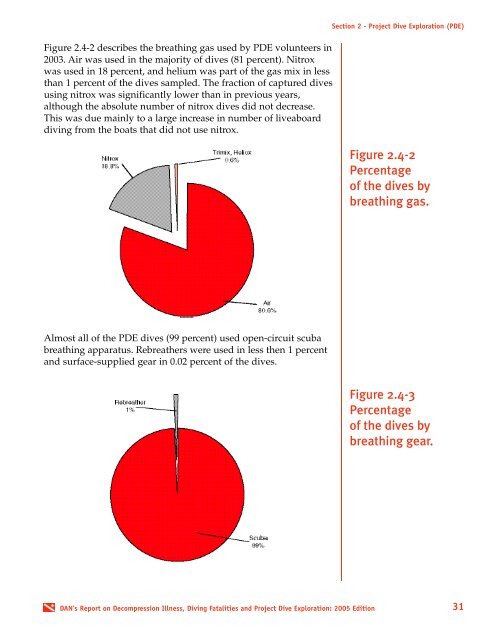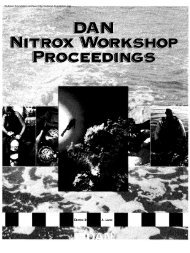- Page 2 and 3: Report on Decompre
- Page 4 and 5: DAN Regions and Regional Coordinato
- Page 6 and 7: DAN - Your DiveSafety AssociationDA
- Page 8 and 9: DAN - Your Dive Safety AssociationD
- Page 10 and 11: DAN - Your Dive Safety AssociationW
- Page 12 and 13: DAN - Your Dive Safety AssociationS
- Page 14 and 15: DAN - Your Dive Safety AssociationA
- Page 16 and 17: DAN - Your Dive Safety AssociationD
- Page 18 and 19: DAN - Your Dive Safety AssociationT
- Page 20 and 21: 1. INTRODUCTIONDivers Alert Network
- Page 22 and 23: Section 1. Introduction1.3 Diving F
- Page 24 and 25: 2.2 PDE 2003This report includes da
- Page 26 and 27: Section 2 - Project Dive Exploratio
- Page 28 and 29: Section 2 - Project Dive Exploratio
- Page 30 and 31: Section 2 - Project Dive Exploratio
- Page 34 and 35: Figures 2.5-2 and 2.5-3 indicate th
- Page 36 and 37: Towards the end of the series, PDE
- Page 38 and 39: Section 2 - Project Dive Exploratio
- Page 40 and 41: Section 2 - Project Dive Exploratio
- Page 42 and 43: Section 2 - Project Dive Exploratio
- Page 44 and 45: Case #2The diver was a 29-year-old
- Page 46 and 47: 3. Dive InjuriesSection 3 - Dive In
- Page 48 and 49: Section 3 - Dive InjuriesFigure 3.1
- Page 50 and 51: Section 3 - Dive Injuriesmost sever
- Page 52 and 53: Section 3 - Dive Injuries3.3 Physic
- Page 54 and 55: Section 3 - Dive Injuries3.4 Charac
- Page 56 and 57: Section 3 - Dive InjuriesDays in Di
- Page 58 and 59: Section 3 - Dive InjuriesFigure 3.5
- Page 60 and 61: Section 3 - Dive InjuriesFigure 3.6
- Page 62 and 63: Section 3 - Dive InjuriesFigure 3.7
- Page 64 and 65: Section 3 - Dive InjuriesFigure 3.7
- Page 66 and 67: Section 3 - Dive InjuriesCase (diag
- Page 68 and 69: 4. Dive FatalitiesDeath while divin
- Page 70 and 71: Section 4 - Dive FatalitiesFigure 4
- Page 72 and 73: Section 4 - Dive FatalitiesFigure 4
- Page 74 and 75: Section 4 - Dive FatalitiesOur data
- Page 76 and 77: Section 4 - Dive FatalitiesFigure 4
- Page 78 and 79: Section 4 - Dive FatalitiesFigure 4
- Page 80 and 81: Section 4 - Dive Fatalities4.4-1Dis
- Page 82 and 83:
Figure 4.4-2Report
- Page 84 and 85:
Section 4 - Dive FatalitiesConclusi
- Page 86 and 87:
Figure 5.1-2 shows the proportion o
- Page 88 and 89:
Figure 5.1-6 shows a comparison of
- Page 90 and 91:
Figures 5.2-3 and 5.2-4 show how th
- Page 92 and 93:
6. Breath-HoldingIncidents6.1 Intro
- Page 94 and 95:
Section 6 - Breath-Holding Incident
- Page 96 and 97:
Section 6 - Breath-Holding Incident
- Page 98 and 99:
Section 6 - Breath-Holding Incident
- Page 100 and 101:
Appendix A: Dive Injury Case <stron
- Page 102 and 103:
Appendix A: Injury Case Rep
- Page 104 and 105:
Appendix A: Injury Case Rep
- Page 106 and 107:
Appendix A: Injury Case Rep
- Page 108 and 109:
Appendix B: Dive Fatality Case <str
- Page 110 and 111:
Appendix B: Fatality Case R
- Page 112 and 113:
Appendix B: Fatality Case R
- Page 114 and 115:
Appendix B: Fatality Case R
- Page 116 and 117:
Appendix B: Fatality Case R
- Page 118 and 119:
Appendix B: Fatality Case R
- Page 120 and 121:
Appendix B: Fatality Case R
- Page 122 and 123:
Appendix B: Fatality Case R
- Page 124 and 125:
Appendix B: Fatality Case R
- Page 126 and 127:
Appendix B: Fatality Case R
- Page 128 and 129:
Appendix B: Fatality Case R
- Page 130 and 131:
Appendix C: Breath-Hold IncidentCas
- Page 132 and 133:
Appendix C: Breath-Holding Incident
- Page 134 and 135:
Glossarymatical models to compute d
- Page 136 and 137:
GlossaryRepresentative SampleA grou
- Page 138 and 139:
2004 Publications2004 PublicationsR
- Page 140 and 141:
NotesDAN’s Report</strong
- Page 142:
The only 24-hour, worldwide dive em
















